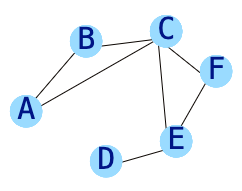Packets and Redundancy
In this activity, you'll test the strength of a network.
An important feature of networks is redundancy.
Network redundancy means multiple paths to get to the same place.
If one path is no longer available for some reason, a message can travel a different path instead.
Consider roads and highways: we might always go to a destination (like a school) using a certain path. However, if one of the roads is under construction one day, we can usually find an alternative way to get to the destination. The alternative route might be slower or more dangerous, but at least we eventually get to the destination. That's the power of redundancy.
- In the previous activity, you probably discovered strategies that used different paths between the same set of routers. Those different paths were redundant paths. Circle two redundant paths on your worksheet.
Break the Network
 More redundancy in a network means more protection in case things go wrong. This network has some redundancy, but not a lot, so there's a lot that can go wrong. You're going to cause some havoc! There are several blocks for taking down parts of the network:
More redundancy in a network means more protection in case things go wrong. This network has some redundancy, but not a lot, so there's a lot that can go wrong. You're going to cause some havoc! There are several blocks for taking down parts of the network:



The cut cable block simulates something that actually happens a lot, cutting the cables connecting two routers. Many cables are either buried underground or lying on the seafloor, so they can easily be damaged by construction companies or ships that don't realize they're there.
In 2019, a
cut cable resulted in the entire island nation of Tonga losing it's entire Internet connection!
The other blocks (destroy router and attack router) simulate taking down individual routers not the cables between them. Natural disasters are a common cause of router loss, since routers can be destroyed or lose power.
- Drag some destruction blocks over to the main area and type router names in the blanks. After you take down part of the network, try sending a message again to see if it can still go through and to see whether it takes an alternate path.
-
There are currently multiple paths from B to D.
- Can you make it impossible for a message to get sent from B to D just by using a single
destroy router or attack router block?
- Can you do it using a single
cut cable block?
-
Try the same from B to E.
- Can you stop a message with a single
destroy router or attack router block?
- What about a single
cut cable block?
Spot the SPOF!
A goal of designing networks is to avoid single points of failure (or SPOFs).
In a network, a SPOF is any connection that will bring down a piece of the network if it fails.
As long as a router has multiple cables connecting it to the rest of the network, none of those cables is a single point of failure. However, if a router has only one connection, that one connection is a SPOF.
-
Can you find the SPOF in this network?

In this activity, explored the limitations of a network by destroying cables and routers.
 More redundancy in a network means more protection in case things go wrong. This network has some redundancy, but not a lot, so there's a lot that can go wrong. You're going to cause some havoc! There are several blocks for taking down parts of the network:
More redundancy in a network means more protection in case things go wrong. This network has some redundancy, but not a lot, so there's a lot that can go wrong. You're going to cause some havoc! There are several blocks for taking down parts of the network:

